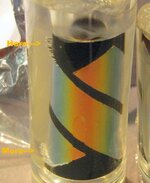Russianwolf
Member
Here's a pic of a rather unique occurance I had. Prepped everything as usual, Didn't apply a sealer coat over the paint as I have done on other batches. Cast vertically (so as it appears in the pic). Cast at 50psi.
Had these lovely bubbles appear. Now they are tiny and stretch from the edge of the dichro out radially toward the plastic tubing used to cast. They did not try to go up towards the surface. Everything else came out great.
I sent these off to Ed and Dawn and Ed has turned one. Talking to him about it he says once down to pen size you can feel them while turning with the skew, but can't feel them with your finger. :bulgy-eyes: I haven't seen them once turned, maybe Ed will post an after pic.
What do you guys think caused this one? I've since made sure to use the seal coat on the paint and not had a reoccurance.
Had these lovely bubbles appear. Now they are tiny and stretch from the edge of the dichro out radially toward the plastic tubing used to cast. They did not try to go up towards the surface. Everything else came out great.
I sent these off to Ed and Dawn and Ed has turned one. Talking to him about it he says once down to pen size you can feel them while turning with the skew, but can't feel them with your finger. :bulgy-eyes: I haven't seen them once turned, maybe Ed will post an after pic.
What do you guys think caused this one? I've since made sure to use the seal coat on the paint and not had a reoccurance.


